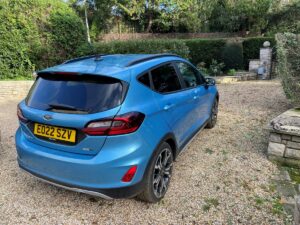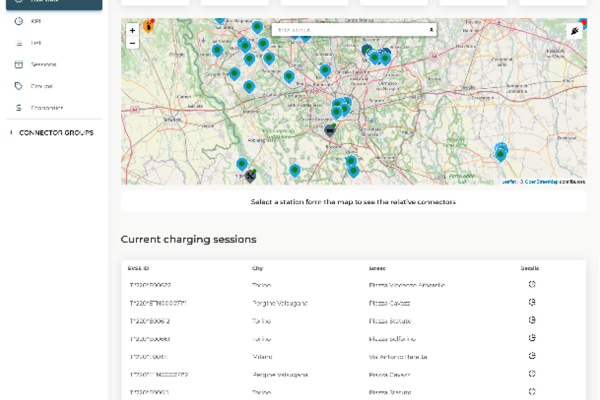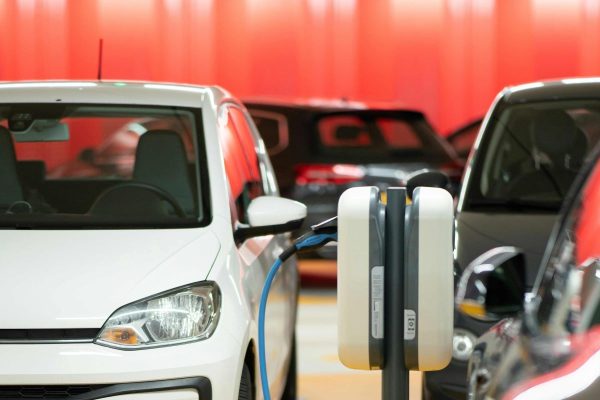What is it?
It’s the first electrified version of Ford’s popular supermini and with immaculate timing we were driving it just when the carmaker announced production was to be discontinued!
So, you have until the middle of next year to get behind the wheel of a Fiesta if you haven’t already done so at some point in the past 45 years.
Yep, 1977 was when the Fiesta first hit the road, a small, affordable car launched in response to the fuel crisis of the 1970s – energy crises are nothing new you might gather.
There’s been changes over the years and the latest model features updated styling, an enhanced technology package and sophisticated mild hybrid powertrains.
This was aimed at make the compact hatchback more “future-ready than ever” according to afford although now, it appears, it doesn’t have a future. Production in Germany will cease in June 2023 while the S-Max and Galaxy MPVs will also be axed as the carmaker realigns its products in readiness for an electrified future.
Ford of Europe said: “We are accelerating our efforts to go all-in on electrification with our passenger vehicles being fully electric by 2030 – and all vehicles across our Ford portfolio by 2035. As we get ready to transition to an electric future, we will discontinue production of S-MAX and Galaxy in Valencia, Spain in April 2023 and discontinue Fiesta production in Cologne, Germany by end of June 2023.”
The company said it plans to sell more than 600,000 electric vehicles in Europe by 2026, and the electric passenger vehicle production at the Cologne Electrification Centre will reach 1.2 million vehicles over a six-year timeframe.
The first Fiesta was produced at Dagenham in 1977 with assembly later being transferred to Germany. It’s popularity has much to do with it affordable entry point into the brand and more than 20 million have been built for customers worldwide.
Plenty to choose from on the used car market as well, then. The current line-up of Fiesta variants. Trend, Titanium, ST-Line and Active models each benefit from unique styling elements alongside an expanded range of exterior colours, wheel designs and interior finishes.
The Fiesta range is also expanded with new Vignale packs that amplify the Titanium, ST‑Line and Active personalities with luxury specifications, in addition to highly-specified X variants.
Latest generation technologies help ensure new Fiesta is better equipped for intelligent, connected driving experiences. LED headlights are for the first time introduced to all Fiesta variants, with advanced Matrix LED technology available that offers Glare-Free High Beam functionality and can also adapt headlight beam patterns for better visibility in challenging conditions.
The new Fiesta also introduces a 12.3-inch digital instrument display that helps drivers stay informed with Local Hazard Information and Wrong-Way Alert making Fiesta debuts among a suite of sophisticated driver assistance technologies.
What do we think?
The latest Fiesta builds on the proven Ford B-car architecture – also utilised by the Ford Puma compact SUV – to deliver a range of practical and refined three- and five-door variants.
Ford’s EcoBoost Hybrid 48-volt mild hybrid technology helps optimise fuel efficiency while simultaneously enhancing Fiesta’s driving dynamics with responsive acceleration. The technology works hand-in-hand with Ford’s Powershift seven-speed automatic transmission option for fast, seamless gearchanges.
Designed to reduce running costs while boosting the fun-to-drive factor at the heart of Fiesta’s appeal, EcoBoost Hybrid models feature a belt-driven integrated starter/generator (BISG) in place of the standard alternator, enabling recovery and storage of energy usually lost during braking and coasting to charge a 48-volt lithium-ion, air-cooled battery pack.
The BISG also acts as a motor, integrating with the engine and using the stored energy to provide torque assistance during normal driving and acceleration, as well as running the vehicle’s electrical ancillaries.
The technology can restart the engine in just 350 milliseconds, enabling the Auto Start-Stop system to turn off the engine in scenarios such as when coasting to a stop below 15 mph even when the vehicle is in gear with the clutch pedal depressed, for even greater fuel savings.
The 1.0-litre EcoBoost Hybrid engine is available with 125 PS and 155 PS power outputs, combined with a six-speed manual transmission. WLTP fuel efficiency from 4.9 l/100 km and CO emissions from 111 g/km represent a 5% improvement compared with a non-hybrid 125 PS 1.0-litre EcoBoost engine, with savings of up to 10% in city driving scenarios according to Ford data. In real world use we averaged just under 48mpg on largely town and country roads.
The 125 PS EcoBoost Hybrid is also available with a seven-speed, Powershift dual-clutch automatic transmission, delivering seamless gear changes for optimised refinement and from 5.2 l/100 km fuel efficiency and 117 g/km CO2 WLTP.
The Powershift transmission helps keep the engine at the optimum speed for efficiency, as well as enabling rolling Auto Start-Stop below 12 km/h (7 mph) for improved fuel efficiency in city driving. The automatic transmission allows triple downshifts for faster overtaking.
Ford’s 1.0-litre EcoBoost engine is offered with 100 PS, delivering from 5.2 l/100 km and 118 g/km CO2 WLTP. Like the EcoBoost Hybrid variant, the engine utilises high-pressure direct fuel injection, Twin-independent Variable Cam Timing and an offset crankshaft design for refined operation, and is available in with a six-speed manual transmission.
There’s also a choice of modes, Normal, Sport and Eco Drive that enables drivers to adjust throttle response, ESC, traction control, plus gearshift timings for automatic models, to match responses and performance to the driving scenarios. Fiesta Active also has Trail and Slippery modes.
A 12.3-inch, fully-configurable TFT digital instrument cluster is introduced to new Fiesta provides the ability to personalise and prioritise information displays including navigation notifications. The cluster features uniquely-themed displays to correspond with selected Drive Modes, and a separate area for high-priority information such as driver assistance technologies.
Ford’s Wrong Way Alert uses a windscreen-mounted camera in combination with information from the car’s navigation system to provide drivers with an audible and visual warning should you drive through two “No Entry” signs on a motorway ramp.
Further sophisticated technologies include Adaptive Cruise Control with Stop & Go and Speed Sign Recognition, while the safety technology can automatically bring car to a complete halt and automatically pull away again in stop-start traffic, in vehicles equipped with the Powershift transmission.
Active Park Assist can detect suitably-sized parking spaces and can control the steering to park hands-free nose-to-tail and side-by-side with other cars, while the driver controls acceleration and braking and gear selection.
Technologies designed to prevent or mitigate the effect of collisions with other road users include Blind Spot Information System (BLIS) with Cross Traffic Alert and Active Braking, Lane-Keeping Aid and Pre-Collision Assist with Active Braking.
Standard FordPass Connect modem technology allows a selection of convenient features to be controlled remotely using the FordPass app. Drivers can operate Door Lock/Unlock, Remote Start for Fiesta models with seven-speed automatic transmission, Vehicle Locator, and Vehicle Status for checking fuel level, alarm status, tyre pressures, oil life and more.
The car’s connectivity also provides Live Traffic updates for the available navigation system and enables Local Hazard Information, which can inform drivers of a hazardous situation on the road ahead even if the incident is not visible due to a bend in the road or other vehicles.
SYNC 3 communications and entertainment system allows drivers to control audio, navigation and connected smartphones using simple voice commands and includes Apple CarPlay and Android Auto, compatibility supported by an 8-inch central touchscreen with pinch and swipe functionality, as well as the ability to display a 180‑degree image from the available rear-view camera.
New Fiesta models equipped with SYNC 3 also now feature Rear Occupant Alert, designed to help drivers avoid leaving children or pets in their vehicle by reminding them to check the back seats when the rear doors have been opened at the start of a journey.
So, a sophisticated bundle of technology wrapped up in a small package, but most important, the latest – and last – Fiesta is just as much fun to drive as it ever was.
Ford Fiesta – From £18,385
| Fiesta 3dr and 5dr | Fuel consumption l/100 km 1 |
Performance |
||||||||||
| Engine | Power (PS) |
CO2 (g/km) |
Combined | Max speed (km/h) | 0-100 km/h 0-62 mph (sec) |
50-100 km/h 31-62 mph (sec) 2 |
||||||
| 1.0-litre EcoBoost (6-spd manual) | 100 | 118-144 | 5.2-6.4 | 180 | 10.8 | 11.1 | ||||||
| 1.0-litre EcoBoost (6-spd manual) | 125 | 119-144 | 5.2-6.4 | 180 | 9.4 | 9.6 | ||||||
| 1.0-litre EcoBoost Hybrid (6-spd manual) | 125 | 111-136 | 4.9-6.0 | 200 | 9.4 | 9.5 | ||||||
| 1.0-litre EcoBoost Hybrid (7-spd Powershift automatic) | 125 | 117-138 | 5.2-6.1 | 199 | 9.9 | N/A | ||||||
| 1.0-litre EcoBoost Hybrid (6-spd manual) | 155 | 111-133 | 4.9-5.9 | 219 | 8.9 | 7.9 | ||||||
| 1.0-litre EcoBoost (100, 125) |
||||||||||||
| Type | Inline three cylinder turbo petrol, Ti-VCT, transverse | |||||||||||
| Displacement | cm3 | 999 | ||||||||||
| Bore | mm | 71.9 | ||||||||||
| Stroke | mm | 82.0 | ||||||||||
| Compression ratio | 10.0:1 | |||||||||||
| Max power | PS (kW) | 100 (74) | 125 (92) | |||||||||
| at rpm | 4500-6000 | 6000 | ||||||||||
| Max torque steady state | Nm | 170 | 170 | |||||||||
| at rpm | 1500-4000 | 1400-4500 | ||||||||||










